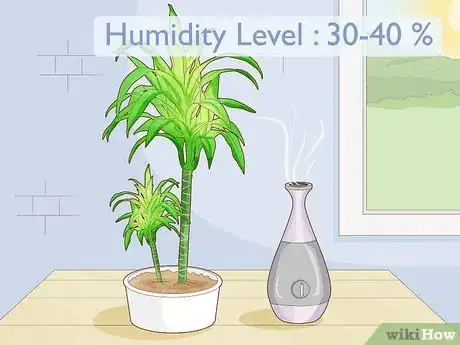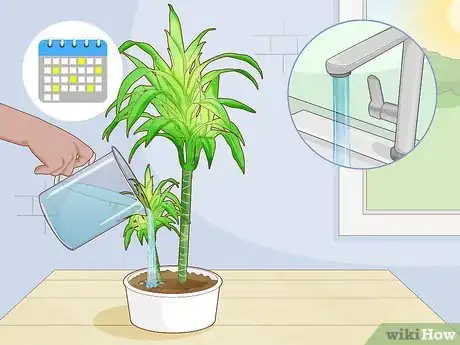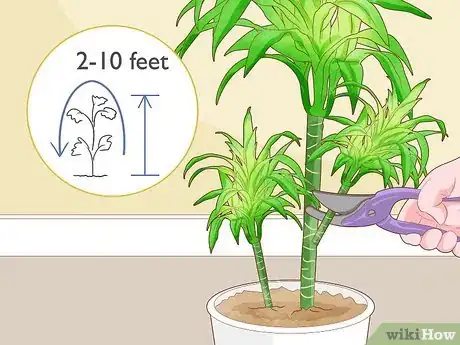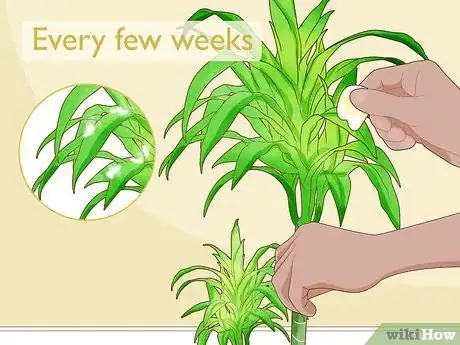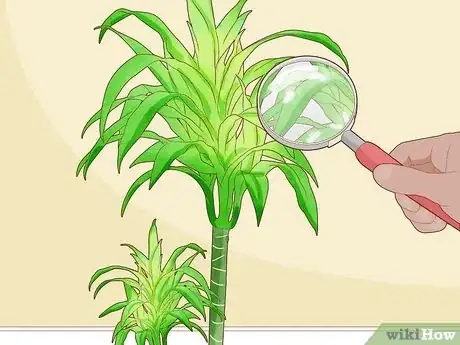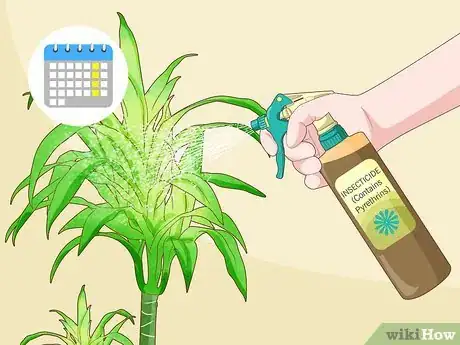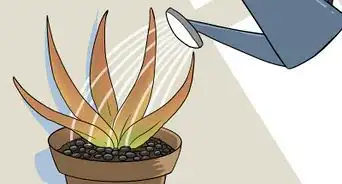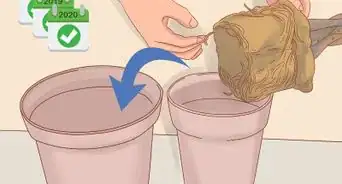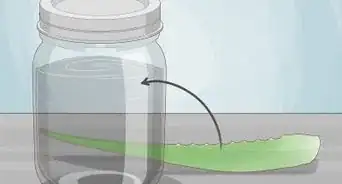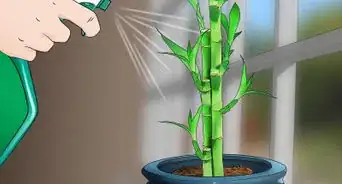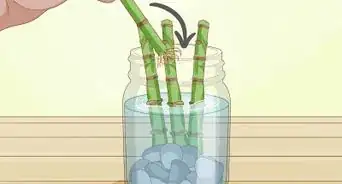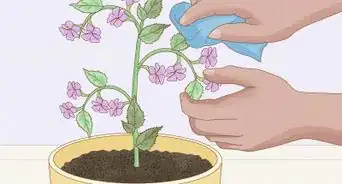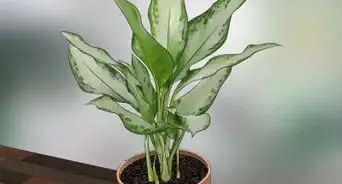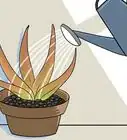This article was co-authored by Chai Saechao and by wikiHow staff writer, Amber Crain. Chai Saechao is the Founder and Owner of Plant Therapy, an indoor-plant store founded in 2018 based in San Francisco, California. As a self-described plant doctor, he believes in the therapeutic power of plants, hoping to keep sharing his love of plants with anyone willing to listen and learn.
There are 9 references cited in this article, which can be found at the bottom of the page.
This article has been viewed 33,079 times.
Dracaena plants are hardy houseplants with a lush, tropical appearance and strap-shaped leaves. They’re attractive, easy to maintain, and can tolerate low light conditions, which makes them popular indoor plants in homes and offices. Thriving dracaena plants can grow up to 10 feet (3.0 m) tall, but you can easily control their height with a bit of pruning. Be sure to repot your dracaena each spring to give it plenty of growing room!
Steps
Creating the Ideal Environment
-
1Provide 2-4 hours of indirect sunlight daily for the healthiest foliage. Dracaenas grow best when they get 2-4 hours of bright, indirect sunlight every day. They will tolerate less light, but growth will slow down significantly and they won’t look as green and leafy.[1]
- Direct sunlight will scorch their foliage, so avoid exposing your dracaena to it.
- A sturdy window sill with east or west exposure will provide an ideal amount of light.
- If you see round, dry patches and streaks on the foliage, your dracaena is probably getting too much sunlight.
-
2Maintain a comfortable temperature of 60–70 °F (16–21 °C). At night, 50–55 °F (10–13 °C) is fine, but don’t let the temperature drop more than that. Dracaenas do not tolerate cold well.[2]
- If your dracaena is positioned near a window during cold weather, pull it away so that no foliage is touching the cold glass.[3]
- If your plant suddenly drops a lot of its leaves, the temperature may need to be adjusted.
Advertisement -
3Place the dracaena in an area with a humidity level of 30-40%. Mount a humidity gauge in the room so you can monitor humidity. Since these plants like an average amount of humidity, up to 50% humidity is fine. When the humidity drops below 30%, which usually only happens in winter, mist the foliage every few days to keep your dracaena happy.[4]
- If you notice the tips and edges of leaves turning brown, the humidity is probably too low. Thorough and regular misting will help.[5]
-
4Water your plant with tepid water when the soil feels dry to the touch. Touch the soil with your fingers every few days to see how moist it is. Whenever the soil feels dry, water your dracaena thoroughly.[6] Cold water will shock the plant, so make sure it's lukewarm. Root rot is a common problem for dracaenas, so take care not to over-water them.[7]
- How much water you give your dracaena will depend on its size, the size of its container, and the soil medium you're using. Let the soil dry completely between each watering, and then give the dry soil a thorough soak.[8]
- If you notice that the leaves have brown tips, you may be overwatering.
- Yellow foliage typically indicates that your plant needs more water.
Tip: Dracaenas are sensitive to flouride, which is commonly found in tap water. Use distilled or bottled water for the best results.[9]
Maintaining Healthy Dracaena Plants
-
1Feed dracaenas liquid fertilizer once a month during spring and summer. Select a well-balanced fertilizer formulated for houseplants. Dilute the liquid fertilizer to half the recommended strength with water and always mist the soil before fertilizing the plant. Then, pour the fertilizer at the base of the plant so that it can soak into the soil. Try to avoid wetting the foliage with liquid fertilizer.
-
2Prune dracaenas in the spring to control the size and shape, if desired. To reduce height, cut off the top part of the plant's main stem with pruning shears. You can cut it back as far as you want. Once you "top" the plant at the main stem, it won't ever grow taller than that. This encourages the dracaena to get fuller and bushier rather than taller.[12] Also, trim off brown or unhealthy leaves at the nodes, which is where leaves sprout from the branch.[13]
- Dracaenas can grow 2–10 feet (0.61–3.05 m) tall, although indoor plants typically max out at 6 feet (1.8 m) tall.
- You can also trim your dracaena into a particular shape, if you’d like.
-
3Wipe the leaves gently with a damp cloth every few weeks to prevent pests. One of the easiest ways to prevent pests is to regularly wipe down the foliage with a damp cloth. Be gentle and be sure to wipe down the underside of the leaves, as well.[14]
- This will also prevent dust from building up on your dracaena, which is a common problem for indoor plants.
-
4Check dracaenas weekly for pests with a magnifying glass. Scale insects, mealybugs, and mites love dracaena plants. Use a magnifying glass to check underneath the leaves for these pests once a week. If you see small brown bumps or cottony white tufts, you have an infestation.[15]
- If your plant suddenly drops a lot of its foliage, you should definitely check it for a pest infestation.[16]
-
5Treat pests with an insecticide that contains pyrethrin. Wet the foliage with an insecticidal spray every 5-7 days, as needed, until the infestation is under control. Drenching the soil with insecticide can also help to control these pests.[17]
- If you don't want to use chemicals, mix warm water with 1–2 teaspoons (4.9–9.9 ml) of mild dish soap and wash off the leaves with the soapy water.[18]
-
6Repot dracaenas once a year to keep them healthy and happy. Wait until spring to repot your dracaena. Lift the plant from its current container and gently remove any soil clinging to the plant’s roots. Transfer the plant to a larger pot and surround it with fresh potting soil around the base. Standard houseplant potting mix works just fine for this.[19]
- Avoid packing the soil too tightly around the plant to maintain good drainage.
- Don’t use soil with white perlite granules, which contain fluoride.[20]
Expert Q&A
Did you know you can get expert answers for this article?
Unlock expert answers by supporting wikiHow
-
QuestionHow do you care for a dracaena plant?
 Chai SaechaoChai Saechao is the Founder and Owner of Plant Therapy, an indoor-plant store founded in 2018 based in San Francisco, California. As a self-described plant doctor, he believes in the therapeutic power of plants, hoping to keep sharing his love of plants with anyone willing to listen and learn.
Chai SaechaoChai Saechao is the Founder and Owner of Plant Therapy, an indoor-plant store founded in 2018 based in San Francisco, California. As a self-described plant doctor, he believes in the therapeutic power of plants, hoping to keep sharing his love of plants with anyone willing to listen and learn.
Plant Specialist The dracaena is a really common and popular house plant. They're hardy, but they do need bright indirect sunlight. Also, make sure that the soil dries out completely before you water them again. Watering your plants once every 2 weeks is generally a pretty good schedule. If the leaves turn yellow, it's generally a sign that you're overwatering your plant.
The dracaena is a really common and popular house plant. They're hardy, but they do need bright indirect sunlight. Also, make sure that the soil dries out completely before you water them again. Watering your plants once every 2 weeks is generally a pretty good schedule. If the leaves turn yellow, it's generally a sign that you're overwatering your plant.
Things You’ll Need
- Humidity gauge
- Pruning shears
- Liquid fertilizer
- Houseplant potting mix
- Damp cloth
Warnings
- Dracaena plants are toxic to cats and dogs. Make sure your pets can’t access the plant.[21]⧼thumbs_response⧽
References
- ↑ https://hgic.clemson.edu/factsheet/dracaena/
- ↑ https://hgic.clemson.edu/factsheet/dracaena/
- ↑ https://pss.uvm.edu/ppp/articles/dracaena.html
- ↑ https://hgic.clemson.edu/factsheet/dracaena/
- ↑ https://pss.uvm.edu/ppp/articles/dracaena.html
- ↑ Chai Saechao. Plant Specialist. Expert Interview. 20 February 2019.
- ↑ https://hgic.clemson.edu/factsheet/dracaena/
- ↑ https://extension.uga.edu/publications/detail.html?number=B1318&title=Growing%20Indoor%20Plants%20with%20Success
- ↑ https://pss.uvm.edu/ppp/articles/dracaena.html
- ↑ https://hgic.clemson.edu/factsheet/dracaena/
- ↑ https://mrec.ifas.ufl.edu/Foliage/folnotes/dracaena.htm
- ↑ https://www.houseplantsexpert.com/pruning-and-repotting-a-madagascar-dragon-tree.html
- ↑ https://www.greenandvibrant.com/dracaena-corn-plant
- ↑ https://pss.uvm.edu/ppp/articles/dracaena.html
- ↑ https://pss.uvm.edu/ppp/articles/dracaena.html
- ↑ https://hgic.clemson.edu/factsheet/dracaena/
- ↑ https://mrec.ifas.ufl.edu/Foliage/folnotes/dracaena.htm
- ↑ https://www.ag.ndsu.edu/extensionentomology/urban-and-forestry-insect-pests/documents/homes/pp-744-houseplants-proper-care-and-management-of-pest-problems-december-2009
- ↑ https://hgic.clemson.edu/factsheet/dracaena/
- ↑ https://pss.uvm.edu/ppp/articles/dracaena.html
- ↑ https://www.aspca.org/pet-care/animal-poison-control/toxic-and-non-toxic-plants/dracaena


